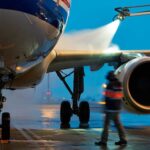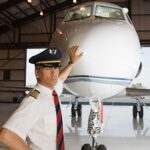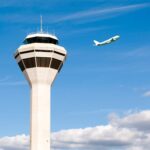
Traveling in a private jet is synonymous with luxury, comfort, and convenience. But when winter rolls around, there’s an important factor that shouldn’t be overlooked: deicing. Ensuring your jet is properly deiced is not just about maintaining that high standard of comfort—it’s crucial for your safety. Let’s dive into the essentials of private jet deicing, so your winter travels are as secure as they are plush.

Key Takeaways
Deicing is critical for private jet safety to prevent ice from altering flight performance.
Anti-icing fluids are used to protect against ice reformation after the initial deicing process.
Planning ahead with your flight crew can minimize delays and ensure a smooth deicing procedure.
Understanding the equipment and techniques used in deicing can enhance your travel experience.
Requesting a quote for deicing services can help manage the cost and efficiency of your winter travel.
The Essentials of Deicing Your Private Jet
Imagine this: you’re all set for your winter getaway, bags packed, and ready to take off into the crisp blue sky. But there’s a hitch – your jet is coated with a thin layer of frost. This is more than just a visual nuisance; it’s a potential safety hazard that affects how the air flows over the wings and controls. Therefore, deicing is the first step before any winter takeoff.
Understanding the Deicing Process
Deicing is the process of removing ice and snow from the aircraft’s surface. It’s done using heated fluids that melt away any frozen precipitation. This is crucial because ice can severely disrupt the aerodynamics of your jet, leading to unsafe flying conditions. Most importantly, this process needs to be done thoroughly and just before departure to prevent reformation.
Key Deicing Chemicals and Their Functions
When it comes to deicing chemicals, there are a few key players:
Type I fluids, typically orange, are heated and applied to melt existing ice.
Type IV fluids, which are green, are thicker and applied after Type I to prevent further ice from forming.
Both these fluids are essential in their own right – one for removing ice and the other for keeping it at bay. It’s not just about getting rid of ice; it’s about making sure it doesn’t come back while you’re waiting for takeoff.
But remember, the timing is everything. These fluids have a limited period where they’re effective, known as the ‘holdover time.’ It’s the window between application and takeoff where the fluid can prevent ice from forming. Therefore, coordination with your flight crew is essential to ensure that deicing is done right before departure.
Pre-Flight Preparations for a Frost-Free Journey
Before you even reach the runway, there are steps you can take to ensure your jet is ready for a swift deicing process.
Checking Weather Forecasts and Flight Plans
Keeping an eye on the weather forecast is not just for deciding what to pack. It informs you and your crew of the likelihood of needing deicing services. If frost, ice, or snow is predicted, it’s a heads-up to your team to arrange for deicing well in advance.
Scheduling Deicing Services in Advance
Coordination with your flight crew is key. Discuss the need for deicing services ahead of time, and make sure they’re booked and ready to go. This proactive step not only ensures that you’re not left waiting but also helps manage the cost. Deicing isn’t cheap, and last-minute services can come with a premium price tag.
Now, let’s talk about the equipment and techniques that make deicing a success.
Deicing Tools and Techniques
Deicing is a bit like a well-orchestrated ballet. It involves precise movements, timing, and the right tools for a performance that ends in a safe takeoff. The equipment used must be reliable and effective, ensuring all ice and snow are removed efficiently.
Types of Deicing Equipment
There are several types of deicing equipment, each serving a specific purpose:
Deicing Trucks: Equipped with high-reach booms and nozzles to spray deicing fluid on the aircraft.
Heated Blankets: Used to gently warm specific areas of the aircraft and melt away any accumulation of ice.
Forced Air Machines: Blow hot air over the aircraft’s surface, effectively removing frost and ice.
Choosing the right type of equipment depends on the conditions and the aircraft. Larger jets may need the power of deicing trucks, while smaller planes might suffice with heated blankets or forced air machines.
However, the most commonly used method involves deicing trucks that spray a heated glycol-based fluid onto the aircraft. This fluid not only melts ice but also prevents further ice from forming for a limited period.
Best Practices in the Deicing Technique
Deicing is not just about spraying fluid and calling it a day. There’s a technique to it:
Start from the top and work your way down, ensuring gravity helps in the removal process.
Focus on critical areas like wings, tail, and control surfaces where ice can have the most detrimental impact on performance.
Ensure the entire surface area is covered with fluid, leaving no room for ice to linger.
Remember, the goal is to have a completely clean aircraft, as even a small amount of ice can impact the aerodynamics and safety of your flight.
Safety Measures for Winter Flights
Safety should always be the top priority, especially during winter flights when conditions can be unpredictable. That’s why it’s essential to have a solid understanding of the safety measures in place for deicing.
Pilots and ground crews follow stringent de-icing protocols to ensure every flight is as safe as possible. These protocols are not just suggestions; they’re mandatory steps that protect you, the passengers, and the crew.
Pilot Checks and Protocols
Before every flight, pilots perform pre-flight checks that include inspecting the aircraft for ice, frost, or snow. If any is found, they must ensure deicing procedures are carried out effectively.
They also keep a close eye on the weather conditions and temperatures. If the temperature is at or below freezing and there’s visible moisture, deicing is a must. Pilots are trained to recognize when conditions warrant deicing and to act accordingly.
Emergency Procedures When Deicing Fails
On the rare occasion that deicing isn’t successful, or if ice forms during flight, pilots have emergency procedures in place. These can include:
Returning to the airport for additional deicing.
Using the aircraft’s own deicing systems to remove ice build-up.
Altering the flight path to avoid areas of icing.
These procedures are part of the pilot’s extensive training and are designed to handle any unexpected icing issues that may arise during flight.
Efficient Deicing: How to Save Time and Resources
Efficiency in deicing is about more than just saving time; it’s about ensuring safety without unnecessary delays. It’s about using the right amount of fluid, the correct technique, and timing the deicing process perfectly with your departure.
Efficiency also involves understanding the costs associated with deicing and how to manage them effectively. This is where being informed and prepared comes into play.
Strategies for Quick Turnaround
To minimize the time spent on deicing, consider the following:
Use a hangar: Storing your jet in a hangar can prevent ice from forming in the first place.
Timing: Schedule deicing as close to departure time as possible within the holdover time.
Communication: Ensure clear communication between the pilot, crew, and deicing team for a synchronized operation.
By being proactive, you can significantly reduce the time and resources needed for deicing, leading to a smoother and more timely departure.
Cost-Effective Deicing Solutions
Deicing can be expensive, but there are ways to manage these costs:
Understand the pricing: Deicing costs can vary based on the size of the aircraft and the type of fluid used. Knowing these details can help you budget accordingly.
Request a quote: Don’t hesitate to ask for a quote from deicing service providers. This will give you a clear idea of the expected costs.
Plan ahead: Booking deicing services in advance can sometimes secure you a better rate than last-minute requests.
Considering the potential costs and disruptions, it’s clear why planning for deicing is an essential aspect of safe winter travel in a private jet. By understanding the process, the necessary equipment, and best practices, you can ensure a seamless and secure journey.
And if you’re looking to manage your travel expenses efficiently, it’s wise to request a quote for deicing services ahead of time. This step not only helps you anticipate the costs but also contributes to a hassle-free luxury travel experience.
With these insights and tips, you’re well-equipped to navigate the winter skies with confidence and sophistication. After all, luxury travel should never compromise on safety, and with the right preparation, it never has to.
Frequently Asked Questions (FAQ)
How often should a private jet be deiced?
Deicing a private jet isn’t about a set schedule; it’s all about the weather conditions. Whenever there’s visible ice, snow, or frost on the aircraft, and the temperature is at or below freezing, deicing is necessary. This could mean deicing before every flight during cold weather periods. It’s not the frequency that matters, but the necessity and timing to ensure safety.
Can a private jet be deiced too much?
While the concern is valid, the risk of ‘over-deicing’ is low. Deicing is performed as needed, based on specific weather conditions and aircraft exposure. The chemicals used are designed to be applied as often as required. However, always using the correct type and amount of deicing fluid is crucial to avoid any potential waste or environmental harm.
That being said, unnecessary application should be avoided not just for cost reasons, but also to minimize environmental impact. Always consult with your crew, who are trained to determine when and how much deicing is necessary for your journey.
What are the risks of not deicing properly?
Skipping or skimping on deicing can have serious repercussions. Ice on an aircraft disrupts the smooth flow of air over the wings, which is essential for lift. Even a thin layer of ice can increase drag and reduce lift, which can lead to performance issues, increased fuel consumption, or, in the worst-case scenario, prevent the aircraft from taking off safely.
Therefore, proper deicing is not just a precaution; it’s a non-negotiable step in ensuring the safety and reliability of your flight. It’s a matter of physics and safety, not just regulations.
How does deicing fluid impact the environment?
Deicing fluids are typically made of propylene glycol or ethylene glycol, which are biodegradable but can still have environmental impacts. When used in large quantities, they can lead to increased Biological Oxygen Demand (BOD) in waterways, which can harm aquatic life.
Airports and service providers are aware of this and often have recovery and recycling systems in place to minimize environmental damage. As a responsible traveler, it’s good to inquire about these practices and support service providers who prioritize environmental stewardship.
What is the role of the crew during the deicing process?
The crew’s role during deicing is crucial. They are responsible for:
Assessing the need for deicing based on weather conditions and aircraft status.
Coordinating with ground services to schedule the deicing procedure.
Ensuring the deicing is performed correctly and thoroughly.
Conducting post-deicing checks to confirm the aircraft is free of contamination.
Communicating with the pilot about the deicing status and any impact on departure times.
The crew works as a cohesive unit to ensure that the deicing process is completed efficiently and effectively, maintaining the highest safety standards for your journey.
As we wrap up this guide, remember that the luxury of private jet travel comes with the responsibility of ensuring a safe experience. Deicing is a critical component of that safety during the colder months. By understanding the ins and outs of the deicing process, you can better plan your trips and communicate with your crew to ensure a seamless and secure travel experience.
Winter travel in a private jet should be nothing short of magical, and with these deicing tips, you’re all set to enjoy the skies with peace of mind. And when it comes to managing the practicalities of deicing, remember that a quote request is a simple step that can save you time and hassle, ensuring that your winter travels are as smooth as freshly deiced wings.













Leave a Reply